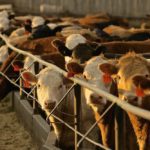Compared to last week, western Canadian feeder cattle markets traded $3-$5 lower on average with some auctions down $5 to as much as $8. Alberta packers were buying fed cattle […] Read more
Tag Archives feedlots

Klassen: Feeder market continues to soften

Feed weekly outlook: A tale of two Prairie grain markets
MarketsFarm — Tight old-crop supplies may be keeping nearby barley bids underpinned on the Prairies — but expectations for increased acres in 2019 mean new-crop bids are at a considerable […] Read more

Walmart creating own Angus beef supply chain
Reuters — Walmart Inc. is taking control of the supply chain for Angus beef sold in some of its stores, cutting out meat processors as the company looks to offer […] Read more

Klassen: Feeder market remains volatile
Compared to last week, western Canadian feeder cattle markets traded $3-$5 on either side of unchanged. Many auction barns were closed last week and the ones holding sales had smaller […] Read more

Feed weekly outlook: Barley acreage buoyed despite current prices
MarketsFarm — International demand for Canadian feed barley has been strong thanks to a 2018 growing season drought in Australia that limited exportable supplies. China purchased nearly 950,000 tonnes of […] Read more

Klassen: Alberta demand drives feeder market higher
Compared to last week, western Canadian yearling prices were $2-$4 higher while calves were relatively unchanged. Stronger fed cattle prices in the deferred positions along with lower new-crop barley values […] Read more

Feed weekly outlook: Barley bids soften as attention turns to new crop
MarketsFarm — Feed barley bids in the key cattle feeding area of southern Alberta are coming under some pressure, as attention begins to turn to the new crop. “Demand is […] Read more

Klassen: Feeder market balancing many variables
Compared to last week, western Canadian yearling markets traded steady to $3 higher while calves were $4 lower to $5 higher depending on the region. Weakness in the live and […] Read more

Klassen: Feeder market incorporates risk premium following U.S. floods
Compared to the previous week, western Canadian feeder cattle sold steady to $4 higher the week ending March 23. Favourable spring weather enhanced demand for yearlings from major finishing operations; […] Read more

Feed weekly outlook: Spring weather may swing Prairie feed markets
MarketsFarm — Weather conditions have the potential to swing feed grain markets in Western Canada over the next few weeks, although prices generally remain steady for the time being. “Spring […] Read more

